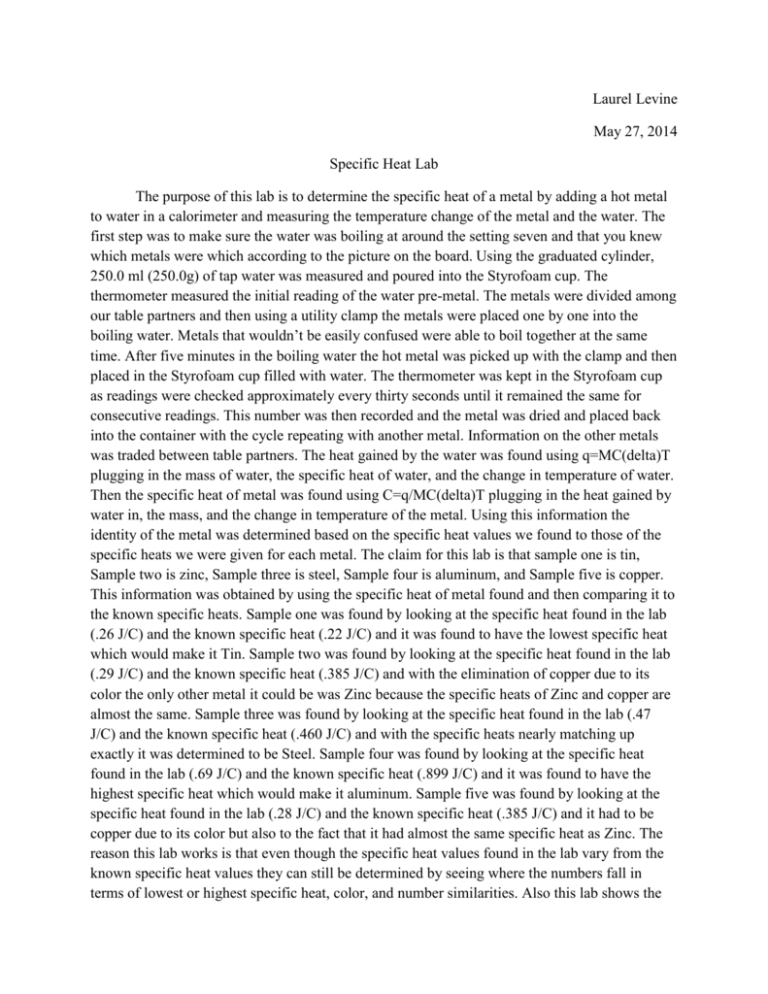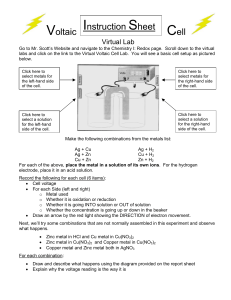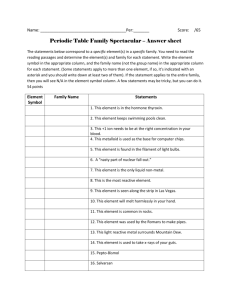File
advertisement

Laurel Levine May 27, 2014 Specific Heat Lab The purpose of this lab is to determine the specific heat of a metal by adding a hot metal to water in a calorimeter and measuring the temperature change of the metal and the water. The first step was to make sure the water was boiling at around the setting seven and that you knew which metals were which according to the picture on the board. Using the graduated cylinder, 250.0 ml (250.0g) of tap water was measured and poured into the Styrofoam cup. The thermometer measured the initial reading of the water pre-metal. The metals were divided among our table partners and then using a utility clamp the metals were placed one by one into the boiling water. Metals that wouldn’t be easily confused were able to boil together at the same time. After five minutes in the boiling water the hot metal was picked up with the clamp and then placed in the Styrofoam cup filled with water. The thermometer was kept in the Styrofoam cup as readings were checked approximately every thirty seconds until it remained the same for consecutive readings. This number was then recorded and the metal was dried and placed back into the container with the cycle repeating with another metal. Information on the other metals was traded between table partners. The heat gained by the water was found using q=MC(delta)T plugging in the mass of water, the specific heat of water, and the change in temperature of water. Then the specific heat of metal was found using C=q/MC(delta)T plugging in the heat gained by water in, the mass, and the change in temperature of the metal. Using this information the identity of the metal was determined based on the specific heat values we found to those of the specific heats we were given for each metal. The claim for this lab is that sample one is tin, Sample two is zinc, Sample three is steel, Sample four is aluminum, and Sample five is copper. This information was obtained by using the specific heat of metal found and then comparing it to the known specific heats. Sample one was found by looking at the specific heat found in the lab (.26 J/C) and the known specific heat (.22 J/C) and it was found to have the lowest specific heat which would make it Tin. Sample two was found by looking at the specific heat found in the lab (.29 J/C) and the known specific heat (.385 J/C) and with the elimination of copper due to its color the only other metal it could be was Zinc because the specific heats of Zinc and copper are almost the same. Sample three was found by looking at the specific heat found in the lab (.47 J/C) and the known specific heat (.460 J/C) and with the specific heats nearly matching up exactly it was determined to be Steel. Sample four was found by looking at the specific heat found in the lab (.69 J/C) and the known specific heat (.899 J/C) and it was found to have the highest specific heat which would make it aluminum. Sample five was found by looking at the specific heat found in the lab (.28 J/C) and the known specific heat (.385 J/C) and it had to be copper due to its color but also to the fact that it had almost the same specific heat as Zinc. The reason this lab works is that even though the specific heat values found in the lab vary from the known specific heat values they can still be determined by seeing where the numbers fall in terms of lowest or highest specific heat, color, and number similarities. Also this lab shows the importance of measuring accurate readings and temperatures in order to get accurate results. An error in this lab could be that the volume of the Styrofoam cup could have varied slightly due to the removal of the metal accidentally removing some water, or the temperature of the boiling water changing slightly between experiments. Also human error could have occurred in terms of reading the thermometer and not waiting a sufficient time before taking the final reading. Things to take away from this lab were calculating heat gained by using q=MC(delta)T and calculating specific heat using C= q / MC(delta)T. Also the use of gathered data in comparison to known data to predict a metal identity is an important thing to be able to do.






